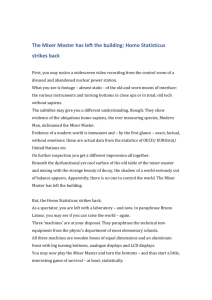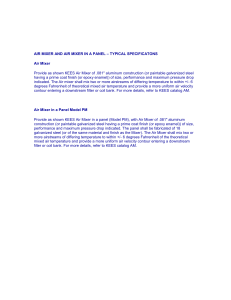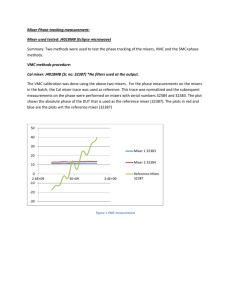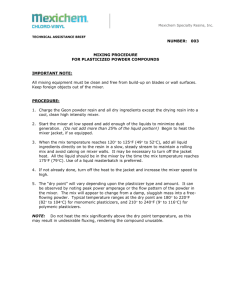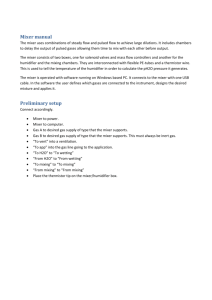OSS (Open Sound System) Tutorial
advertisement
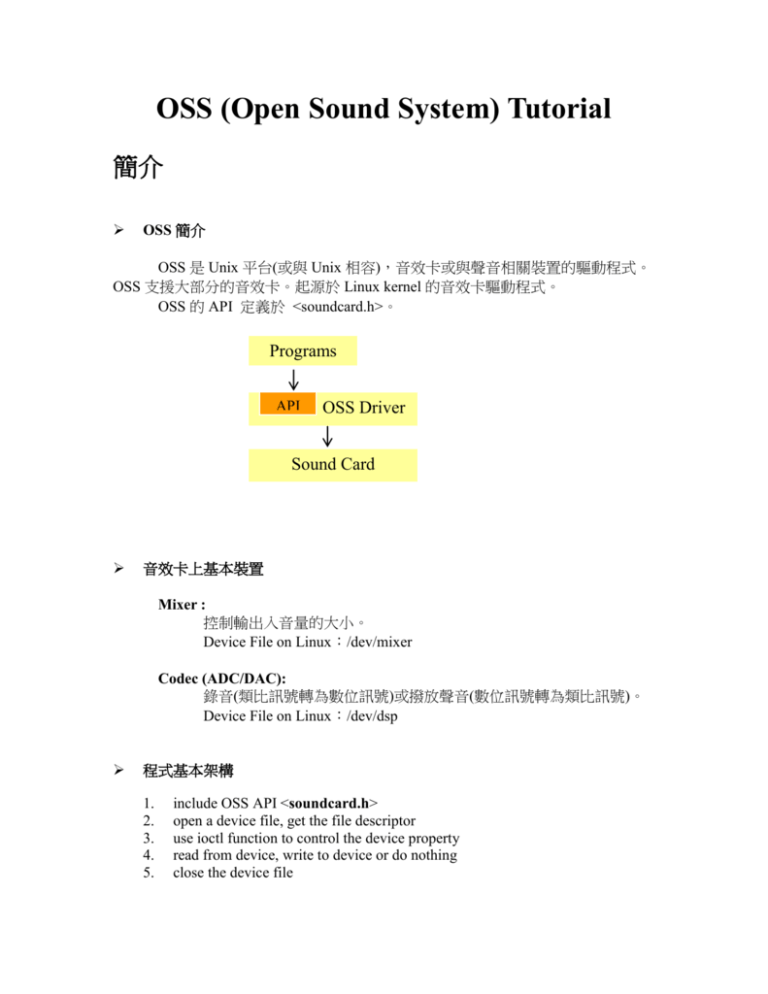
OSS (Open Sound System) Tutorial
簡介
OSS 簡介
OSS 是 Unix 平台(或與 Unix 相容),音效卡或與聲音相關裝置的驅動程式。
OSS 支援大部分的音效卡。起源於 Linux kernel 的音效卡驅動程式。
OSS 的 API 定義於 <soundcard.h>。
Programs
API
OSS Driver
Sound Card
音效卡上基本裝置
Mixer :
控制輸出入音量的大小。
Device File on Linux:/dev/mixer
Codec (ADC/DAC):
錄音(類比訊號轉為數位訊號)或撥放聲音(數位訊號轉為類比訊號)。
Device File on Linux:/dev/dsp
程式基本架構
1.
2.
3.
4.
5.
include OSS API <soundcard.h>
open a device file, get the file descriptor
use ioctl function to control the device property
read from device, write to device or do nothing
close the device file
範例一:
#include <sys/ioctl.h>
#include <fcntl.h>
#include <stdio.h>
#include <sys/soundcard.h>
int main() {
int mixer_fd;
if ((mixer_fd = open(“/dev/mixer”,O_RDONLY,0)) == -1) {
perror(“mixer”);
exit(1);
}
int vol = 0x3f3f;
ioctl(mixer_fd, MIXER_WRITE(SOUND_MIXER_VOLUME),&vol);
close(mixer_fd);
return 0;
}
此範例的功能為改變輸出音量的大小,詳細說明請參考 Mixer Programming。
Mixer Programming
Mixer Channels
每個 mixer channel 代表 mixer 中一個控制硬體的物件,例如控制麥克風音量大
小的物件,或是喇叭輸出音量的物件。不同的 channel 在 OSS 中,用不同的編
號來表示,在 OSS API 中,則定義一個 Macro 來表示。
常用的 Channel Macros
Marco
SOUND_MIXER_VOLUME
SOUND_MIXER_TREBLE
SOUND_MIXER_BASS
SOUND_MIXER_PCM
SOUND_MIXER_MIC
SOUND_MIXER_CD
SOUND_MIXER_LINE
Description
輸出音量大小的主要控制。
控制所有 channel 輸出高音的大小。
控制所有 channel 輸出低音的大小。
控制聲音裝置(/dev/dsp)輸出音量的大
小。
控制從麥克風輸入信號的大小。
控制從 CD 輸入信號的大小。
控制外接 player 輸入信號的音量大小。
SOUND_MIXER_NRDEVICES : 在 soundcard.h 中已定義的 channel 數量。
音量控制
音量範圍:0 – 100
讀取音量的大小
int vol;
ioctl(mixer_fd, MIXER_READ(channel_macro) , &vol);
設定音量的大小
int vol = 0x5f5f;
ioctl(mixer_fd, MIXER_WRITE(channel_macro) , &vol);
channel_macro 為所想要控制的 Mixer Channel Macro
音量格式:
Undefined
16 bits
右聲道
8 bits
左聲道
8 bits
立體聲:
右聲道值=左聲道值。
Ex.
int vol = 0x 5f5f
單一聲道: 右聲道值為未定義。
Ex.
int vol = 0x 5f;
參考範例一。
查詢 Mixer 的狀況
Macro
Description
SOUND_MIXER_READ_DEVMASK
查詢可用的 Mixer Channels。
SOUND_MIXER_READ_RECMASK
查詢可用的 Mixer Channels。
SOUND_MIXER_READ_STEREODEVS 查詢 Mixer Channels 為立體聲或單一聲道。
語法 :
int mask;
ioctl(mixer_fd, SOUND_MIXER_READ_xxxx, &mask);
之前提過 OSS 將 Mixer Channels 編號,因此所傳回的 mask 中,如果第 n
個 bit 為 1,則代表編號為 n 的 Channel 是 enable。
查詢某個 Channel:
if (mask & (1 << channel_macro))
printf(“channel_macro enables”);
範例二:
#include <sys/ioctl.h>
#include <stdio.h>
#include <unistd.h>
#include <fcntl.h>
#include <sys/soundcard.h>
void availChannel(unsigned mask) {
if (mask & (1 << SOUND_MIXER_VOLUME))
printf("SOUND_MIXER_VOLUME\n”);
if (mask & (1 << SOUND_MIXER_MIC))
printf("SOUND_MIXER_ MIC \n”);
if (mask & (1 << SOUND_MIXER_BASS))
printf("SOUND_MIXER_ BASS\n”);
}
void main() {
int mask;
int mixer_fd;
//mixer file descriptor
// open /dev/mixer
if ((mixer_fd = open("/dev/mixer", O_WRONLY)) == -1) {
perror("open /dev/mixer error");
exit(1);
}
// get available mixer mask
if (ioctl(mixer_fd, SOUND_MIXER_READ_DEVMASK, &mask) == -1)
perror("checking available mixer channels error!");
else {
printf("Available Mixer Channel:\n");
availChannel(mask);
}
// get available recording device(channel)
if (ioctl(mixer_fd, SOUND_MIXER_READ_RECMASK, &mask) == -1)
perror("checking available recroding channels error!");
else {
printf("Available Recording Channel:\n");
availChannel(mask);
}
// get stereo or mono info, 1 for stereo, 0 for mono
if (ioctl(mixer_fd, SOUND_MIXER_READ_STEREODEVS, &mask) == -1)
perror("checking stereo channels error!");
else {
printf("Available Stereo Channel:\n");
availChannel(mask);
}
close(mixer_fd);
}
設定錄音來源
語法:
int mask = 0;
mask |= (1 << channel_macro);
ioctl(mixer_fd, SOUND_MIXER_WRITE_RECSRC, &mask);
Audio Programming
主要目的:錄音或撥音。
方法一 :
錄音:
放音:
cat /dev/dsp > xyz
cat xyz > /dev/dsp
缺點為無法設定一些參數,如 sample rate, sample format……
方法二 :
1.
2.
Open the device file “/dev/dsp”
設定基本參數
Sample Format
常用 Sample Format Macros
Name
Description
AFMT_QUERY
詢問目前聲音格式
Unsigned 8-bit
AFMT_U8
16-bit signed little-endain(Intel)
AFMT_S16_LE
16-bit signed big-endain(SPARC…)
AFMT_S16_BE
AFMT_S16_NE
自動檢查要用哪一種 16 bit 格式
Logarithmic mu-law audio encoding
AFMT_MU_LAW
Logarithmic A-law audio encoding
AFMT_A_LAW
Little endian
V.S.
Big-endian :
a = 0x1234
Little endian: end with less significant byte
a
34 12
address low
high
Big endian: end with most significant byte
a
12 34
address low
high
Channel Number (mono, stereo, multiple)
最多支援 16 聲道。
Methods for handle multiple channel (depends on hardware) :
1. Interleaved multi channel audio : only one device file,record
or play the N channels samples one after one for each time slot.
2. Multiple audio device method : several device files : one file
for one channel sample ( /dev/dspM for channel 1, /dev/dspM+1
for channel 2 ….)
Sample Rate
Telephone Quality:8 KHz or 11.025 KHz
Radio Quality:22.05 KHz
CD Quality:44.1KHz
DVD Quality:98KHz
3.
4.
5.
設定其他參數 (mixer or buffer)
Read ( Record ) / Write ( Play )
Close file
暫停
用兩個 bits 去控制是否暫停,一個 bit 控制錄音,一個 bit 控制撥音。bit
為 1 表正常錄撥音,bit 為 0 表暫停錄撥音。
PCM_ENABLE_OUTPUT
PCM_ENABLE_INPUT
int enable_bits = ~ PCM_ENABLE_OUTPUT;
ioctl(audio_fd, SNDCTL_DSP_SETTRIGGER, & enable_bits);
範例三:
#include <sys/ioctl.h>
#include <unistd.h>
#include <fcntl.h>
#include <stdio.h>
#include <sys/soundcard.h>
#include <string.h>
enum mode { PLAY, REC };
void usage(void) {
fprintf(stderr,
"usage: demo<options>\n"
"options:\n"
"
play <filename>\n"
"
rec <filename>\n");
exit(1);
}
int main(int argc, char *argv[]) {
int audio_fd;
int omode;
mode mode;
char para;
char filename[30] ;
if (argc < 3)
usage();
if (strcmp(argv[1], "play") == 0) {
mode = PLAY;
omode = O_WRONLY;
strcpy(filename, argv[2]);
} else if (strcmp(argv[1], "rec") == 0)
mode = REC;
omode = O_RDONLY;
strcpy(filename, argv[2]);
} else {
usage();
}
// open device file
if ((audio_fd = open("/dev/dsp",omode,0)) == -1) {
perror("/dev/dsp");
exit(1);
}
/*
Setting Sampling Parameters
1. sample format
2. number of channels
3. sampling rate
*/
int format;
format = AFMT_S16_NE;
if (ioctl(audio_fd,SNDCTL_DSP_SETFMT, &format) == -1) {
perror("SNDCTL_DSP_SETFMT");
exit(1);
}
int channels = 2;
if (ioctl(audio_fd, SNDCTL_DSP_CHANNELS, & channels) == -1) {
perror("SNDCTL_DSP_CHANNELS");
exit(1);
}
int speed = 44100; //44.1 KHz
if (ioctl(audio_fd, SNDCTL_DSP_SPEED, &speed) == -1) {
perror("SNDCTL_DSP_SPEED");
exit(1);
} else
printf("Support 44.1 KHz , Actual Speed : %d \n",speed);
/*
it won’t be actually 44.1 KHz , codec devices usually generate the
sampling clock by dividing the frequency of crystal the oscillator
inside soundcard.
*/
int music_fd;
signed short applicbuf[2048];
int count;
if (mode == PLAY) {
if ((music_fd = open(filename, O_RDONLY, 0)) == -1) {
perror(filename);
exit(1);
}
while ((count = read(music_fd, applicbuf, 2048)) > 0) {
write(audio_fd, applicbuf, count);
}
} else { //recording
if ((music_fd = open(filename, O_WRONLY | O_CREAT, 0)) == -1) {
perror(filename);
exit(1);
}
int mixer_fd;
if ((mixer_fd = open("/dev/mixer", O_WRONLY)) == -1) {
perror("open /dev/mixer error");
exit(1);
}
//set the recording source
int testchan = SOUND_MIXER_CD;
int recsrc = (1 << testchan);
if (ioctl(mixer_fd, SOUND_MIXER_WRITE_RECSRC,&recsrc) == -1) {
perror("CD");
exit(1);
}
/*
recording three minutes
sample format :16bit
channel num: 2 channels
sample rate = speed
data rate = speed * 2 * 2 bytes/sec
*/
int totalbyte= speed * channels * 2 * 60 * 3;
int totalword = totalbyte/2;
int total = 0;
while (total != totalword) {
if (totalword – total >= 2048)
count = 2048;
else
count = totalword – total;
read(audio_fd, applicbuf, count);
write(music_fd, applicbuf, count);
total += count;
}
close(mixer_fd);
}
close(audio_fd);
close(music_fd);
return 0;
}
Advanced Programming
It’s not recommended only if you are trying to sync audio with some external events
such as graphics.
Buffering
Data in app data segment buffer
read() /write() data in kernel DMA buffer
在一般的情況下常使用的是 double buffering,不過 OSS 卻是採用 multi-buffering,
因為考慮 real time performance。一般情況下,一開始程式會等到一個 buffer 都滿了
之後才開始撥音,如果 buffer size 太大,才會有一段時間的延遲,對於 real time 的
程式來說是不可行的,因此 OSS 將 buffer 分成一堆小的 fragment,而程式開始時只
須等兩個 fragment 滿了就開始撥音。一般的情況下我們並不需要去考慮 fragment size
的大小,OSS 會計算出程式的 data rate 自動幫我們調整 buffer 和 fragment 的大小。
Double buffering
One is being accessed by device, while the one is being read or write by app
Multi-buffering
audio CD quality : 172 KB/sec small buffer is likely to fail
increase buffer size latency increase OSS solution : fragment the buffer
(multi-buffering)
Small
fragment size
improves real-time performance.
Determine Buffering Parameters
Get Fragment Size:
int frag_size;
ioctl(audio_fd, SNDCTL_DSP_GETBLKSIZE, &frag_size)
Set Fragment Size:
int arg = 0xMMMMSSSS;
ioctl(audio_fd, SNDCTL_DSP_SETFRAGMENT, &arg)
fragment size = 2 ^SSSS bytes ( if SSSS = 0008, fragment size = 2 ^8 = 256 )
fragment numbers = 0x MMMM
Synchronization Issues
Get Played or recorded data bytes from the beginning of opening the device
file:
count_info info;
ioctl(audio_fd, SNDCTL_DSP_GETIPTR, &info);
ioctl(audio_fd, SNDCTL_DSP_GETOPTR, &info);
struct count_info {
int bytes;
//number of bytes processed since opening the device
int blocks; // number of fragment processed since previous call to ioctl
int ptr; // offset of current play/record position from beginning of buffer
};
played_time=info.bytes / bytes_per_sec
now_frame = played_time * frame_per_sec
使用 SNDCTL_DSP_GETOPTR / SNDCTL_DSP_GETIPTR 的缺點是不夠精
確,例如如果錄音時 data rate 很快,而 I/O 不能及時將 buffer 的資料送給程式,
則會有一部份的 data 被覆蓋(overrun),利用 SNDCTL_DSP_GETIPTR 所得到的
byte 所算出的時間則並不正確。而且錯誤會不斷的累積,算出的時間會越來越
不準。
not precise use SNDCTL_DSP_GETODELAY /
SNDCTL_DSP_GETIDELAY instead (returns the number of unplayed bytes
in kernel buffer) avoid error accumulation
需要檔案格式的支援,定義成很多塊 packet,每個 packet 中包含一段 video data
和一段 audio data 以及 data 之間 timing 的訊息。

